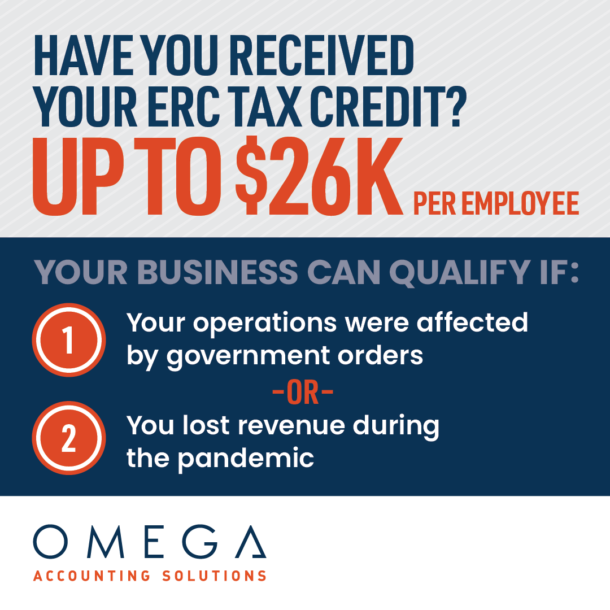With travel getting back to normal and industry trade show season in full go-mode, the Mechanical Hub team has been talking with a lot of manufacturers and contractors about the challenges of the past two years and what everyone sees on the horizon. One of the hot topics recently has been the Employee Retention Tax Read more
COVID-19 pandemic

With travel getting back to normal and industry trade show season in full go-mode, the Mechanical Hub team has been talking with a lot of manufacturers and contractors about the challenges of the past two years and what everyone sees on the horizon. One of the hot topics recently has been the Employee Retention Tax Credit (ERC). Enacted alongside the Paycheck Protection Program (PPP) in 2020, the ERC was widely overlooked until recently. We asked our professional friends over at Omega Accounting Solutions to share some insights into the program and here are their tips.

When the COVID-19 pandemic began to shut down businesses across the U.S., significantly impacting the economy, the federal government intervened by authorizing billions in economic stimulus through the PPP and the ERC program.
The ERC program gave eligible employers a payroll tax credit for continuing to employ Americans during the pandemic. Many employers took out SBA-guaranteed PPP loans in 2020 but bypassed the ERC. In subsequent legislation, the ERC was made available to more ailing businesses, including those who received PPP funds. Many more businesses qualified for ERC money than claimed it.
______________________________________________________
APPETITE FOR CONSTRUCTION PODCAST
 Did we hear that right? The IRS would write us a check? What is the Employee Retention Credit and who is eligible? The boys take this bonus episode to talk with Omega Accounting Solutions’ J.P. Lowry all about this credit and why business owners need to take advantage of it.
Did we hear that right? The IRS would write us a check? What is the Employee Retention Credit and who is eligible? The boys take this bonus episode to talk with Omega Accounting Solutions’ J.P. Lowry all about this credit and why business owners need to take advantage of it.
______________________________________________________
Construction companies that have already taken advantage of the ERC have received hundreds of thousands of dollars in return from the government because they overpaid payroll taxes during the pandemic. Qualifying through gross receipts, an electrical contracting company in California received an ERC refund of $2.6 million from the IRS. Through gross receipts, a construction company in Texas acquired a $975K ERC refund. Through suspension of services, a landscaping company in Utah received an ERC refund of $437K.

5 Reasons Why Construction Companies Should Apply
- Most Businesses Qualify: Construction companies may qualify if they had to close or limit capacity due to government closures, supply chain issues or distancing requirements.
- Projects/jobs were suspended due to government orders
- Materials suppliers were unable to make deliveries of critical goods
- Operating hours were affected by curfew or cleaning protocols
- Social distancing requirements reduced crew sizes
- Receive up to $26,000 per employee: When first introduced as part of the CARES Act in 2020, the maximum credit allowable under the ERC was $5,000 per employee. With its renewal and expansion under the Consolidated Appropriations Act (CCA), 2021, the maximum credit increased to $21,000. When the ERC and the PPP were rolled out under the CARES Act, businesses had to choose which to use. Many selected PPP because it was easier to sign up for a Small Business Administration-backed loan than to learn the details of eligibility for ERC. However subsequent legislation expanded the eligibility requirements for employers so that they could now receive both, making this a can’t-miss opportunity for construction businesses.
- It’s Retroactive: Though the Infrastructure Investment and Jobs Act (IIJA) of 2021 moved up the ERC’s expiration date, effectively repealing the program for the fourth quarter of 2021, construction companies are still allowed to submit their payroll tax filings for the covered periods. Employers who filed their payroll taxes in 2020 were able to deduct the money directly from their quarterly payroll taxes at that time. Those who didn’t file in 2020 or who are claiming the ERC for the first time on their payroll taxes in 2021 will be refunded for quarterly filed periods.
- It’s a Cash Refund: The ERC is a federal credit determined by a business’ quarterly payroll taxes, not the business’ taxes, and based on how many full-time employees (30+ hours) the company had during the eligibility period. The credit calculation is based on qualified wages paid per employee each quarter. In 2020 the refundable tax credit was 50% of qualified wages up to a $5,000 maximum. In 2021 it was 70% of qualified wages up to $21,000. The IRS issues a refund check in the amount of the credit claimed.
- It’s Easier Than You Think: If a construction business meets the eligibility requirements for the ERC, the credit can be claimed on previously filed payroll tax forms. ERC specialists working in accounting departments and for tax preparers can quickly evaluate whether a company is entitled to the credit and provide any needed guidance. If the criteria are met, these professionals can file amended payroll tax returns for the qualifying quarters and submit them to the IRS.
https://youtu.be/wnvLJr1C96g
Find out if your company qualifies for the ERC by clicking this link: https://bit.ly/mechanicalhub
In addition to the ERC, the federal government has introduced other credits designed to help businesses weather the long-term effects of the pandemic and to encourage both innovation and the employment of American workers. Companies should talk with their tax preparers about these additional credits available to them including the Research & Development (R&D) tax credit, available to companies developing new or improved business components, and the PPP forgivable loan program, also established during the CARES Act and implemented and backed by the Small Business Administration.
For over 15 years, Omega Accounting Solutions has been a champion of small- to mid-sized businesses, empowering owners to make informed business decisions. As an accounting and data firm, Omega helps business owners navigate the complexities of the accounting process, particularly for the enormous opportunities around the Employee Retention Credit. Omega has a documented process for the ERC and limits risk for clients. Over $350 million in ERC cash has been recovered for Omega clients, spanning across an impressive range of industries. For more information about qualifying for the ERC and receiving a free evaluation from Omega Accounting Solutions, visit https://bit.ly/mechanicalhub
